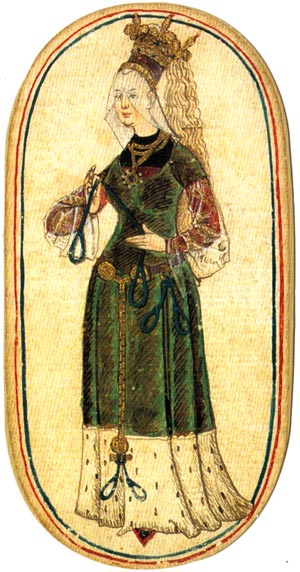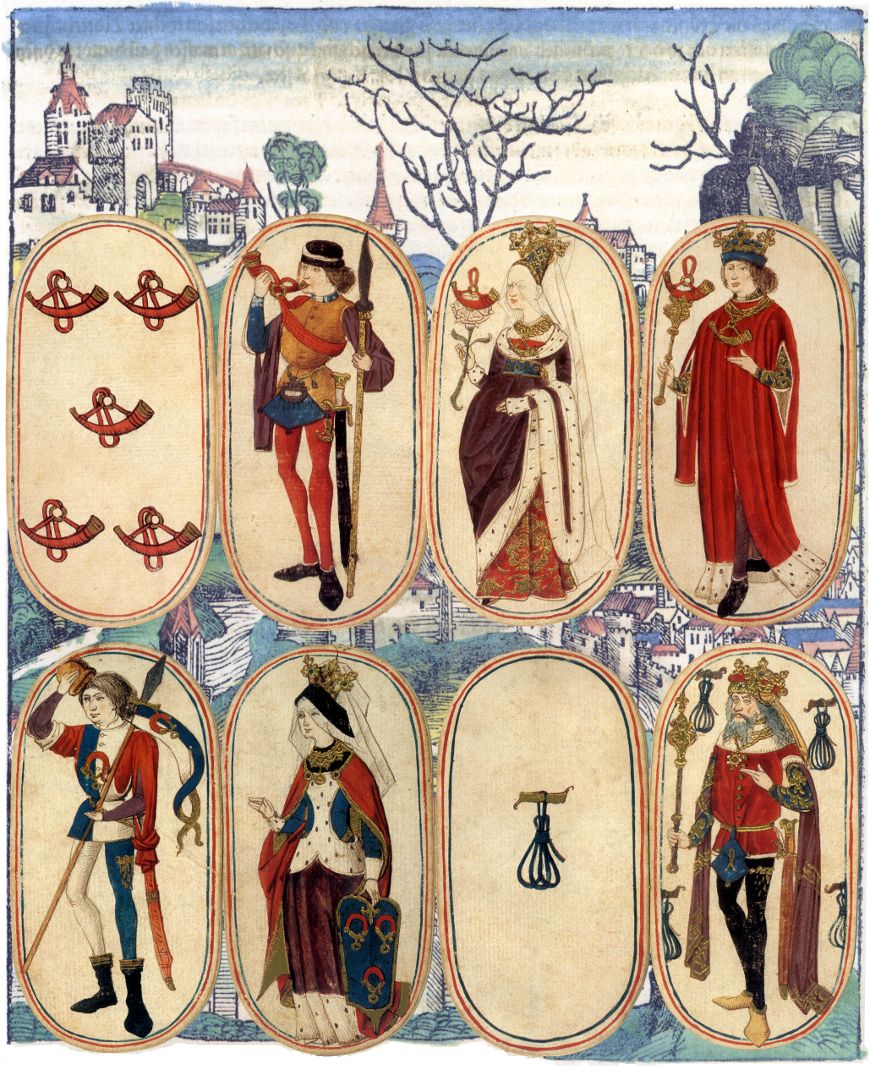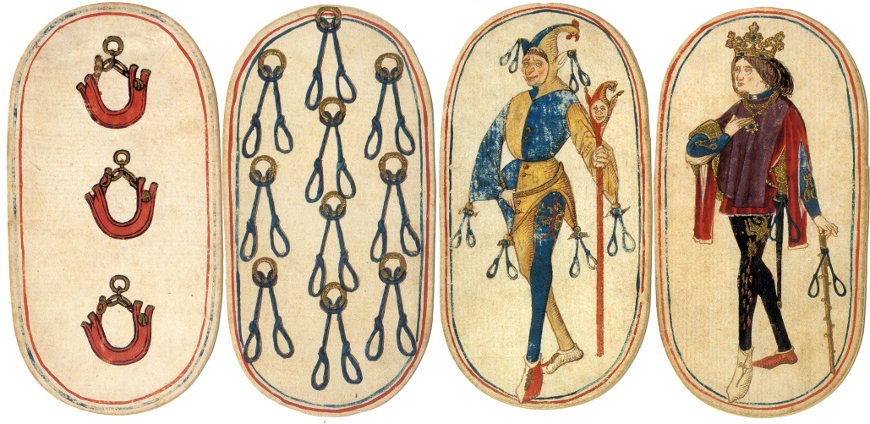Flemish Hunting Deck
Set of medieval playing cards with King, Queen, Knave and numeral cards from one to ten in each of four suits which refer to the activity of hunting, as practiced by the nobility.

Flemish Hunting Deck, c.1475-80
South Netherlandish (Burgundian Territories). Pasteboard with pen and ink, tempera, applied gold and silver.
Fifteenth century playing cards display little conformity amongst themselves in terms of the number of cards, their shape, suit symbols or court card hierarchy. This unique set of medieval playing cards has 52 cards with King, Queen, Knave and numeral cards from one to ten in each of the four suits of dog collars, tethers (for the hounds), gaming nooses (for birds or small game), and hunting horns. The collars and horns are red and the tethers and nooses are blue. These suits refer to the pursuit of hunting, as practised by the nobility. See: press article►
The cards are made from four sheets of paper glued together to form a stiff pasteboard. The oval outline of each card was traced onto the card and the unpainted cards were then cut out. The border around each card was then scored so that the blue and red lines could be painted in afterwards. Stencils were probably used to ensure the uniformity of the suit symbols, whilst the court cards were produced entirely freehand. Representation of court figures was not yet bound by any convention, so these figures uniformly stand in three-quarter profile with one foot leading forwards, holding objects in their hand. The artist's style suggests an origin in the Burgundian Lowlands (former French province and modern-day French région). The backs of the cards are plain paper, unpainted.


Above: cards from the hand-drawn and painted Flemish Hunting Deck believed to have been produced in France or Burgundy, late XV century. The court cards are dressed in costumes fashionable at the courts of the Burgundian dukes in the second and third quarters of the fifteenth century. The Knave of Collars is apparently a Jester and holds a Jester's staff in one hand, whilst hooking the thumb of his other hard under his belt. The colour pigments include red ochre, earth green, azurite and lead-tin yellow, bound in gum arabic, as well as gold and silver. The techniques employed in the manufacture of these cards suggest that they were the product of a workshop whose operations were governed by a division of labour and by regulations which would have been in force in the local area. The cards shown are from the facsimile edition published by Piatnik, Vienna, 1994, which contains a descriptive booklet written by Timothy B. Husband. The original cards are preserved in The Cloisters Collection, The Metropolitan Museum of Art (1983.515.1–.52)►
This is one of a short series of ancient reproductions by Piatnik. See also: Ambraser Hofjagdspiel Stuttgart Hunting Pack Hunting depicted in Playing Cards►

By Simon Wintle
Member since February 01, 1996
I am the founder of The World of Playing Cards (est. 1996), a website dedicated to the history, artistry and cultural significance of playing cards and tarot. Over the years I have researched various areas of the subject, acquired and traded collections and contributed as a committee member of the IPCS and graphics editor of The Playing-Card journal. Having lived in Chile, England, Wales, and now Spain, these experiences have shaped my work and passion for playing cards. Amongst my achievements is producing a limited-edition replica of a 17th-century English pack using woodblocks and stencils—a labour of love. Today, the World of Playing Cards is a global collaborative project, with my son Adam serving as the technical driving force behind its development. His innovative efforts have helped shape the site into the thriving hub it is today. You are warmly invited to become a contributor and share your enthusiasm.
Related Articles

Tarot de las Coscojas
Historical playing card design, tarot symbolism and an almost psychedelic medieval surrealism.

Never Mind the Belote
Limited edition Belote pack with designs by a collective of 24 street artists.

Sannois dans les étoiles
Celebrities and buildings associated with Sannois, a commune in the suburbs of Paris.

Le Globe Céleste
Views and plans of five international exhibitions held in Paris between 1855 and 1900.

Le Journal de Mickey
Perforated sheet of cards with Disney characters issued with the magazine Le Journal de Mickey.

Tarot hiéroglyphique égyptien
The design of the cards draws inspiration from various religious and philosophical traditions merged...

La Réussite (Sébastien Féraut)
Sébastien Féraut’s designs inspired by the animal kingdom for a set promoting patience games.

Le Tarot de Sète
Reinterpretation of the Tarot de Marseille by Julien Labat, an artist from Sète.

Oracle Rock
Cartomantic set depicting rock and pop stars, designed by La Rata, with a book by Virginie Despentes...

Jeu Numismatique
European coins of all periods replace the traditional courts and pips.

Jeu Philatélique
Cards with French postage stamps featuring famous literary figures.

Tarot Philatélique
Tarot game pack with French postage stamps on all the courts, aces and trumps.

Jeu Philatélique – Les Colonies Françaises
Philatelic card game featuring real postage stamps from the French colonies.

Barok
Dutch pack from the 1950s with colourful Baroque courts, reprinted in 1983.

Victorian grocer’s scale plate
Large flat plate decorated with highly coloured English cards and royal arms.

Tarot Actuel 1984
Major arcana to cut out, issued with the French magazine Actuel, using photographic images.
Most Popular
Our top articles from the past 28 days







